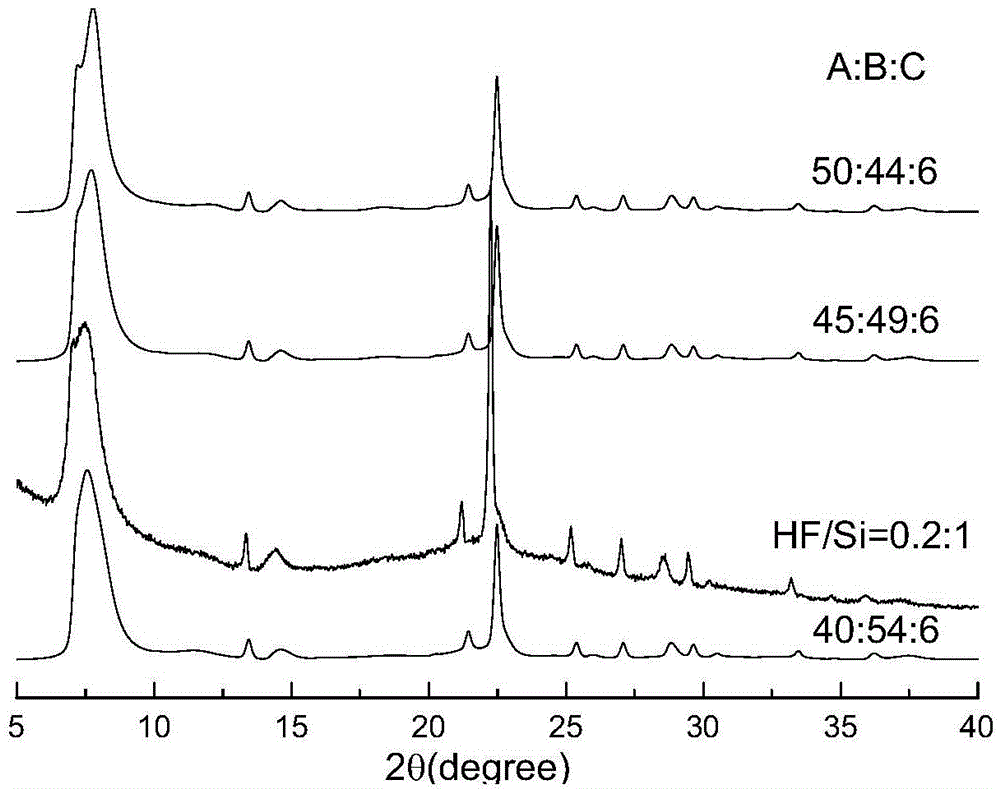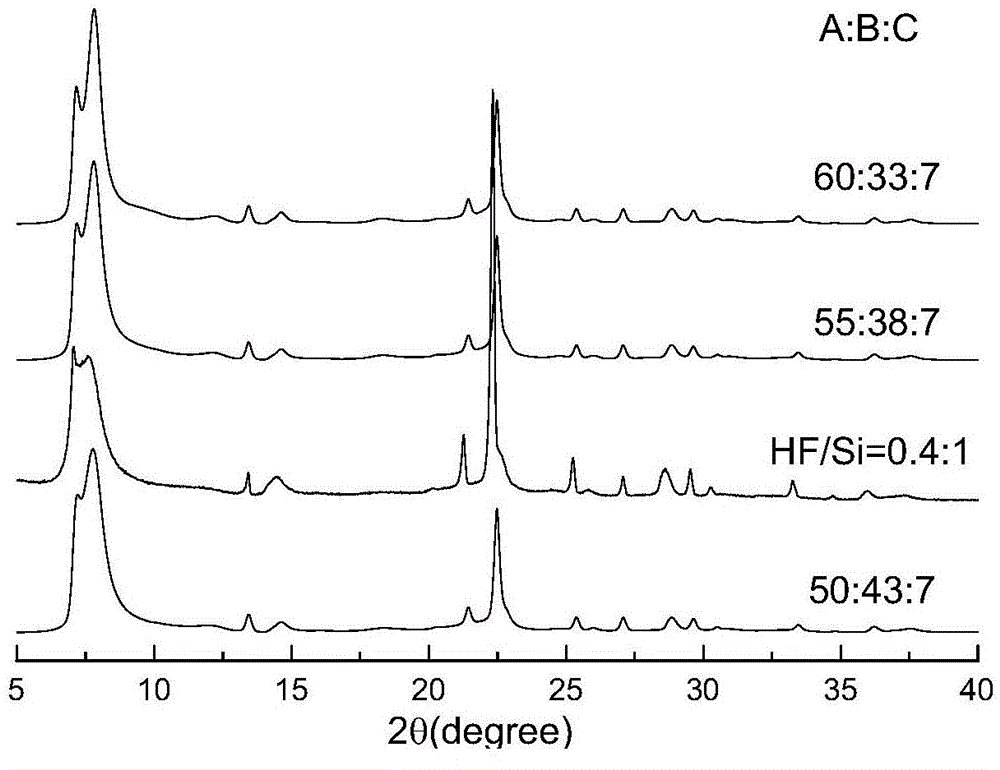Beta molecular sieve with adjustable relative content of polymorphs and synthetic method thereof
A technology of relative content and synthesis method, applied in the field of Beta zeolite molecular sieve preparation
- Summary
- Abstract
- Description
- Claims
- Application Information
AI Technical Summary
Problems solved by technology
Method used
Image
Examples
Embodiment 1
[0050] Beta molecular sieves with adjustable relative content of polymorphs were synthesized under the condition that the molar ratio of fluorine source to silicon source was 0.2:1.
[0051] Add 7.27g of N-isobutyl-N-methylpyrrole hydroxide aqueous solution with a mass fraction of 43.73% into the beaker, then add 15g of deionized water and 8.33g of tetraethyl silicate, and stir at room temperature for 3 Hours, then continue stirring in a constant temperature water bath at 60°C to promote the hydrolysis of tetraethyl silicate until the molar ratio of water to silicon source reaches 4:1 to form a gel, and at this time, add hydrogen with a mass fraction of 40% to the gel drop by drop 0.50g of hydrofluoric acid, stirred evenly, transferred to a 30ml polytetrafluoroethylene-lined stainless steel hydrothermal kettle and crystallized in an oven at 175°C for 7 days. After the crystallization was completed, the product was taken out and washed with deionized water until neutral. Transf...
Embodiment 2
[0054] Beta molecular sieves with adjustable relative content of polymorphs were synthesized under the condition that the molar ratio of fluorine source to silicon source was 0.3:1:
[0055] Add 7.27g of N-isobutyl-N-methylpyrrole hydroxide aqueous solution with a mass fraction of 43.73% into the beaker, then add 15g of deionized water and 8.33g of tetraethyl silicate, and stir at room temperature for 3 Hours, then continue stirring in a constant temperature water bath at 60°C to promote the hydrolysis of tetraethyl silicate until the molar ratio of water to silicon source reaches 4:1 to form a gel, and at this time, add hydrogen with a mass fraction of 40% to the gel drop by drop 0.75g of hydrofluoric acid, stirred evenly, transferred to a 30ml polytetrafluoroethylene-lined stainless steel hydrothermal kettle and crystallized in an oven at 175°C for 7 days. After the crystallization was completed, the product was taken out and washed with deionized water until neutral. Transf...
Embodiment 3
[0058] Beta molecular sieves with adjustable relative content of polymorphs were synthesized under the condition that the molar ratio of fluorine source to silicon source was 0.4:1:
[0059] Add 7.27g of N-isobutyl-N-methylpyrrole hydroxide aqueous solution with a mass fraction of 43.73% into the beaker, then add 15g of deionized water and 8.33g of tetraethyl silicate, and stir at room temperature for 3 Hours, then continue stirring in a constant temperature water bath at 60°C to promote the hydrolysis of tetraethyl silicate until the molar ratio of water to silicon source reaches 4:1 to form a gel, and at this time, add hydrogen with a mass fraction of 40% to the gel drop by drop 1.00g of hydrofluoric acid, stirred evenly, transferred to a 30ml polytetrafluoroethylene-lined stainless steel hydrothermal kettle and crystallized in an oven at 175°C for 7 days. After the crystallization was completed, the product was taken out and washed with deionized water until neutral. Transf...
PUM
| Property | Measurement | Unit |
|---|---|---|
| quality score | aaaaa | aaaaa |
Abstract
Description
Claims
Application Information
 Login to View More
Login to View More - R&D
- Intellectual Property
- Life Sciences
- Materials
- Tech Scout
- Unparalleled Data Quality
- Higher Quality Content
- 60% Fewer Hallucinations
Browse by: Latest US Patents, China's latest patents, Technical Efficacy Thesaurus, Application Domain, Technology Topic, Popular Technical Reports.
© 2025 PatSnap. All rights reserved.Legal|Privacy policy|Modern Slavery Act Transparency Statement|Sitemap|About US| Contact US: help@patsnap.com



